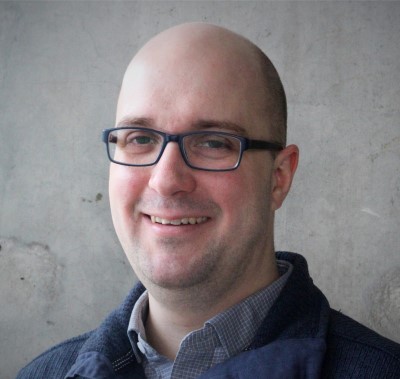Welcome to Christopher Trudeau, new CIRM member!
Christopher Trudeau is a PhD candidate in information studies at McGill University. For the past few weeks, he has been a member of CIRM. His research focuses on sound in Montréal, environmental justice and public health. We caught up with him to find out more about his projects.
You're studying environmental justice of beneficial and detrimental soundscapes from a human health perspective. What motivated you to study this subject?
I've been part of Sounds in the City for 6 years. We assist with interventions, initially in the Plateau Mont-Royal (such as the pedestrianization of Roy Street, or Place Fleurs-de-Macadam). These are very interesting projects, which bring a lot to the area, but it's still just the Plateau, which is a borough that already has many places with good sound quality. But I used to live next to a marshalling yard in Point Saint Charles, which was very noisy. The place where I worked was so different from where I lived in terms of sound, that I wondered about it. I realized that it raised so many inequalities that I decided to go for my doctorate with this issue in mind.
What is environmental justice?
It's not just about pollutants (air, water, noise), but also about the environmental resources to which we have access (such as green spaces, spaces near waterways, access to clean water, etc.). Environmental justice also analyzes the inequalities experienced by different social groups (such as racialized groups, or groups with lower incomes), so there are all kinds of social factors at play.
When we talk about environmental justice from a sound perspective, it encompasses two aspects. Firstly, if you're exposed to noise, it increases your health risks, in terms of hearing of course, but there are other risks too, such as cardiovascular problems. And the risks increase with the level of noise exposure. Secondly, there are places where you can relax, such as parks. But on both counts, there are questions of inequality. Are we overexposed to noise if, for example, we belong to a low-income group? Still, if you're part of this group, do you have access to spaces where you can get away from the noise and relax? That's what I want to see, especially in the case of Montréal.
In Montréal, what is the main environmental justice issue in terms of noise and human health?
There are clearly inequalities in exposure. In Montréal, what has been documented are low-income people and various ethnic groups; the conclusions are clear: these groups are overexposed to noise. That's a problem.
Related to this problem is the perception of noise. People often tend to say that noise bothers them, disturbs their sleep and so on. So people are aware of these problems, and this awareness is spreading, but how much do people know that this is a risk for them? How much do they want to get away from noise? How much do they choose where to live based on noise, especially when there are other factors to consider, such as the cost of housing? Do people think they're stuck accepting situations of noise overexposure, unable to do anything about it, or do they think it's not so bad? How much do we need to do to reduce noise sources? How much do we accept them? All these questions of noise perception are at the heart of what I'm studying.
Take the REM, for example: yes, it's noisy. Its noise emerges from the background noise (by 10 and sometimes even 20 decibels, enough to wake someone up), but the background noise in Griffintown is very high indeed! But we don't talk about that! Background noise exceeds accepted standards, often reaching 65 decibels throughout the day where we took the measurements. At that level, it's a health hazard. But people seem to accept this situation more than the noise emitted by the REM, or even the noise emitted by bars and concert halls, because people can complain about the noise of the REM or the bars, whereas ambient noise, much less so.
How do you think CIRM will help you in your research?
The best thing about CIRM is that it's a network of people who talk about the same theme, Montréal, but from different angles. We can help each other and exchange ideas about Montréal, but on different points. Noise is just one aspect of the city, but it cuts across many other issues, such as mobility (more cars, more noise), or air quality. For me, it's interesting to see Montréal from different angles, different themes, and sound is one of them.
Now, a few quick questions about Montréal! In a few words, how would you describe the metropolis to non-Montrealers?
It's a dynamic city, but with many facets. Non-Montrealers frequent the tourist areas (like the Old Port or downtown), but it's interesting to see other neighborhoods, like Verdun and its linear park. You can be in the city and still have space to see a lot of nature.
What do you think makes a perfect day out in Montréal?
Going to Parc des Rapides and watching the birds.
Favorite neighborhood?
Verdun
Iconic symbols?
Let's go for sound symbols! The metro is a must! I'm also thinking of the bells of Notre-Dame. The third that comes to mind is the sound of rapids.
Books on soundscapes and environmental justice recommended by Christopher:
Aletta, F., Oberman, T., & Kang, J. (2018). Associations between positive health-related effects and soundscapes perceptual constructs: A systematic review. International Journal of Environmental Research and Public Health, 15(11), 2392.
Delaunay, D., Apparicio, P., Séguin, A.-M., Gelb, J., & Carrier, M. (2019). L’identification des zones calmes et un diagnostic d’équité environnementale à Montréal. The Canadian Geographer / Le Géographe canadien, 63(2), 184–197. https://doi.org/10.1111/cag.12511
Trudeau, C., King, N., & Guastavino, C. (2023). Investigating sonic injustice: A review of published research. Social Science & Medicine, 326, 115919. https://doi.org/10.1016/j.socscimed.2023.115919
